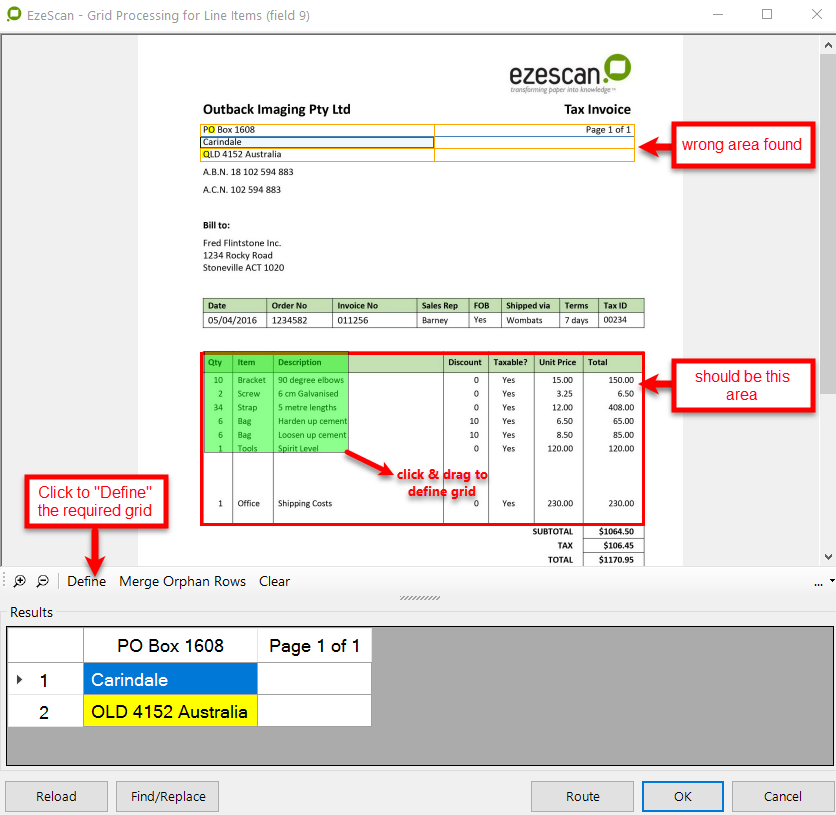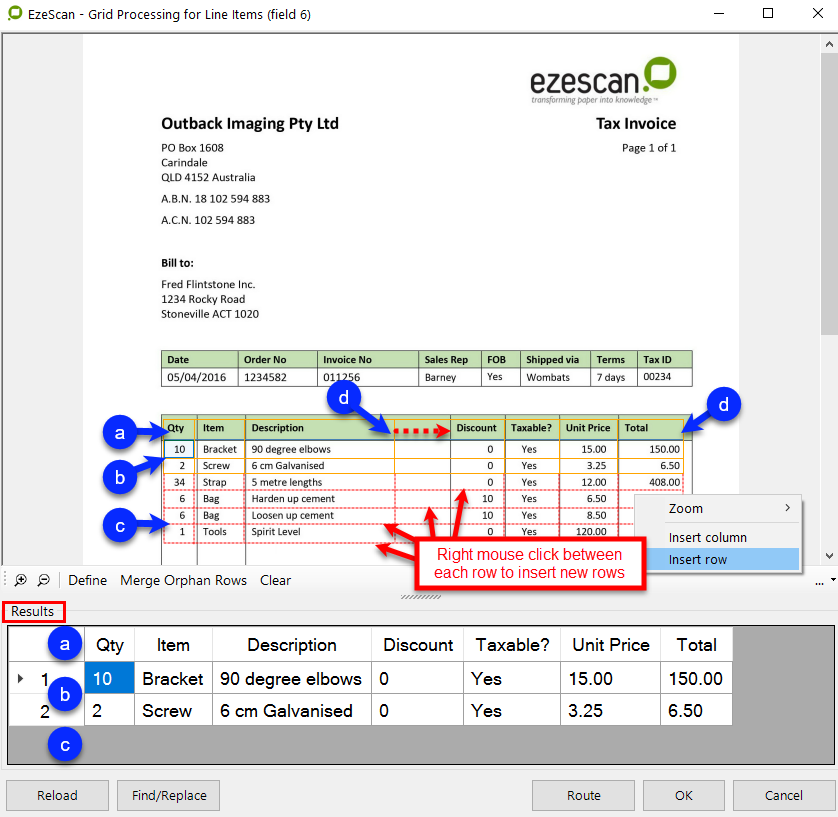Basic/simple Line Items job
It is assumed that you have the skills to create the Job and KFI. This example only focuses on the Line Items functionality.
About the job
This very basic job will process 1 or more single page invoices and create 3 different types of output files.
PDF File for each scanned/imported invoice
Header File (CSV "combined" format) for all invoices captured
Line Items File (CSV format) for each invoice
The set-up does not utilise any advanced type of settings, including using discovery to capture the invoices details. It's very basic & uses manual captured.
See Advanced Line Items job example for advanced setting example
Setting up the Job
The EzeScan Job imports 1 or more invoice pages
The job creates a PDF file for each invoice in the default output folder
Naming convention of files is Invoice # <<F5>> from <<F2>> dated <<F4>>
Setting up the KFI
The EzeScan KFI has 9 fields:
ABN <<F1>>uses zone pen to capture the details; removes the spaces
Supplier Name <<F2>>uses zone pen to capture the details
Order Number <<F3>>uses zone pen to capture the details
Invoice Date <<F4>>uses zone pen to capture the details; formatted date to DD-MM-YYYY
Invoice Number <<F5>>uses zone pen to capture the details
Gross Total <<F6>>uses zone pen to capture the details; removes the $ symbol
Tax Total <<F7>>uses zone pen to capture the details; removes the $ symbol
Sub (Net) Total <<F8>>uses zone pen to capture the details; removes the $ symbol
Line Items <<F9>>captured <<GridValues>>
KFI Output tab -
Combined output file On
Custom Format On
Quote Values On
In the File Format pane click Data. In the fields to check select all except Line Items. (Line Items data will be output in a separate CSV file)
Click Add Columns (Data and Header rows are automatically populated)
Custom Name - Header file for invoices processed <<S3(DD-MM-YYYY)>>
Type CSV
Extension CSV
Click OK to Save
There is no Upload associated to this set-up.
Files are exported to the default output folder set in the Job: C:\ProgramData\Outback Imaging\EzeScan\Output\<<JOB>>
Field 9 Line Items set-up - in KFI
After creating all KFI fields (above) the Line Items field needs to be configured
To enable Grid processing set Format tab Data Settings to Grid

A Grid Settings tab appears after the Format tab. Click the tab then Grid Settings button
Output tab
Output Headers On
enable Grid to Separate Output File set format CSV
File Name set to Line Items Inv# <<F5>> from <<F2>> dated <<F4>>.CSV
Quote Output On
View tab
Untick all options
Running the job
Click Import to browse the available PDF or TIF file containing single invoice pages
Select files & Open
Press F4 to profile and use the "Zone Pen" capture tool to capture each field

When you press enter after completing the Sub (Net) Total field the Line Items function will automatically open the Grid processing for Line Items window
In this example below the first attempt to locate the line items grid (in yellow) identified the incorrect area as shown at right.

It is fairly easy to address; click on the Define option and drag your cursor over the required grid area
The Grid area to select does not include values such as Subtotal, Tax, or Total which are captured as Header field values F6, 7 , and 8.
EzeScan will then re-process the grid and present the line items as shown in the following image
Additional alignment work may be required as outlined below
EzeScan will attempt to identify the invoice grid but may need some manipulation as shown in the steps below from the image
a. The header is identified which display in the Results section at bottom of window
b. The line items are identified which display in the Results section at bottom of window
c. Some lines may not be picked up. They are easily added by right mouse clicking between the lines and selecting Insert row. The new rows will appear in the Results section as they are added
d. Some columns may not be in the correct place. They are easily moved by clicking on the line and dragging it to the appropriate location. New column lines may also be added by right mouse clicking on the required location and selecting Insert Column.
If the initial grid detection has located the correct table location it is not necessary to click Define. Position adjustment of the active rows and columns in yellow, as well as adding or removing columns and rows can be performed. The captured grid output will dynamically update in Results as the grid lines are modified.

You may need to make slight adjustments to the details in the Results section, such as spelling etc. The fields are generally highlighted in yellow
Once all of the Results items are looking good click on the Submit/OK button and you will return to the Profiling window.
Click Submit to complete the process.

There are 3 output files created by the process:

Header File (CSV) - viewed in Notepad

Header File (CSV) - viewed in MS Excel
Opening the CSV file using MS Excel may actually change the formatting of the values such as dates & currency. Take extreme care if doing this - do not make any changes and/or save the file when closing it.

Line Items File (CSV) - viewed in Notepad

Line Items File (CSV) - viewed in MS Excel
Opening the CSV file using MS Excel may actually change the formatting of the values such as dates & currency. Take extreme care if doing this - do not make any changes and/or save the file when closing it.

